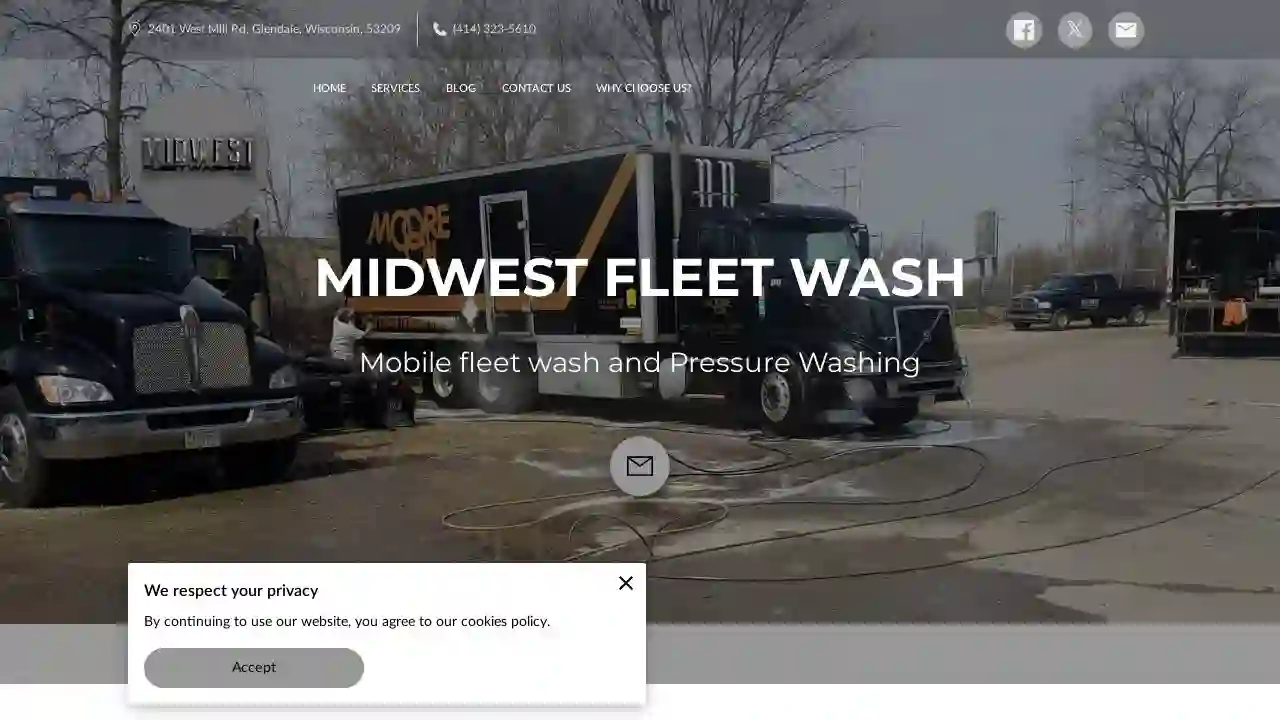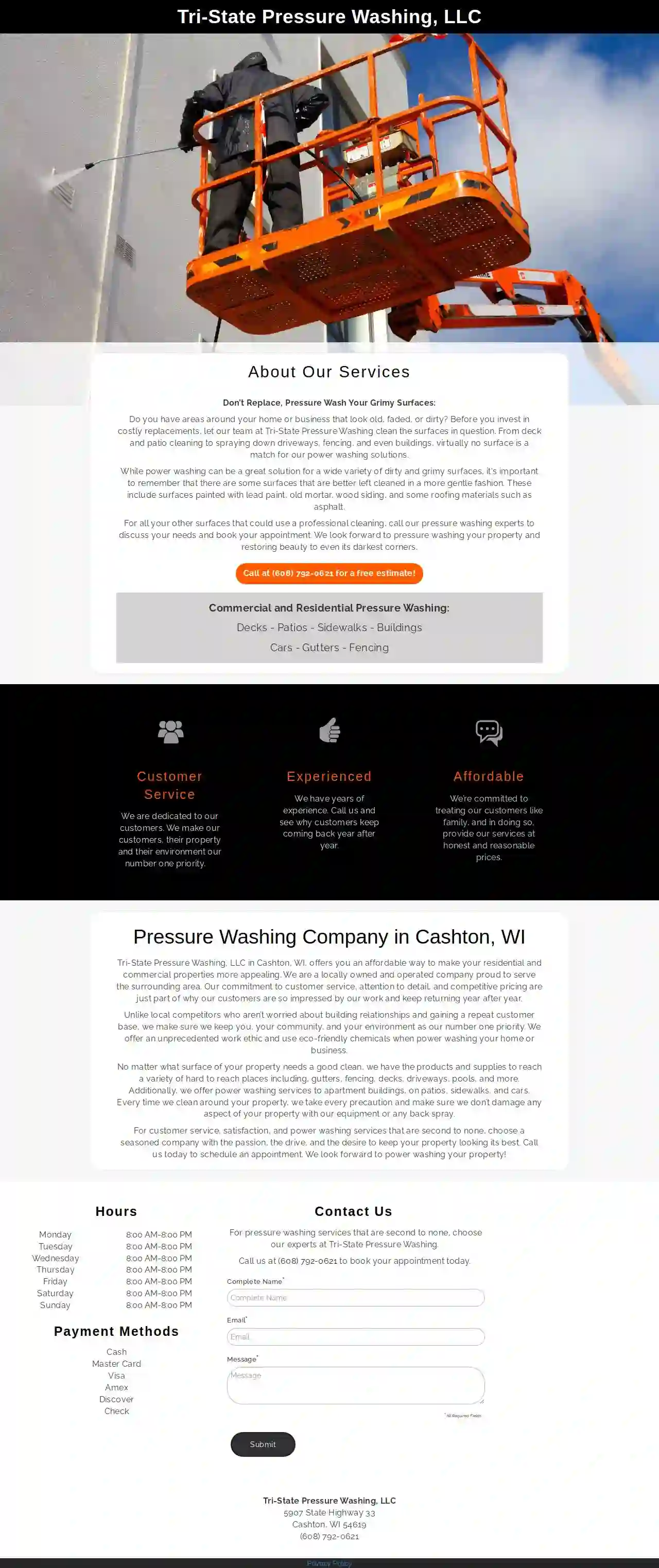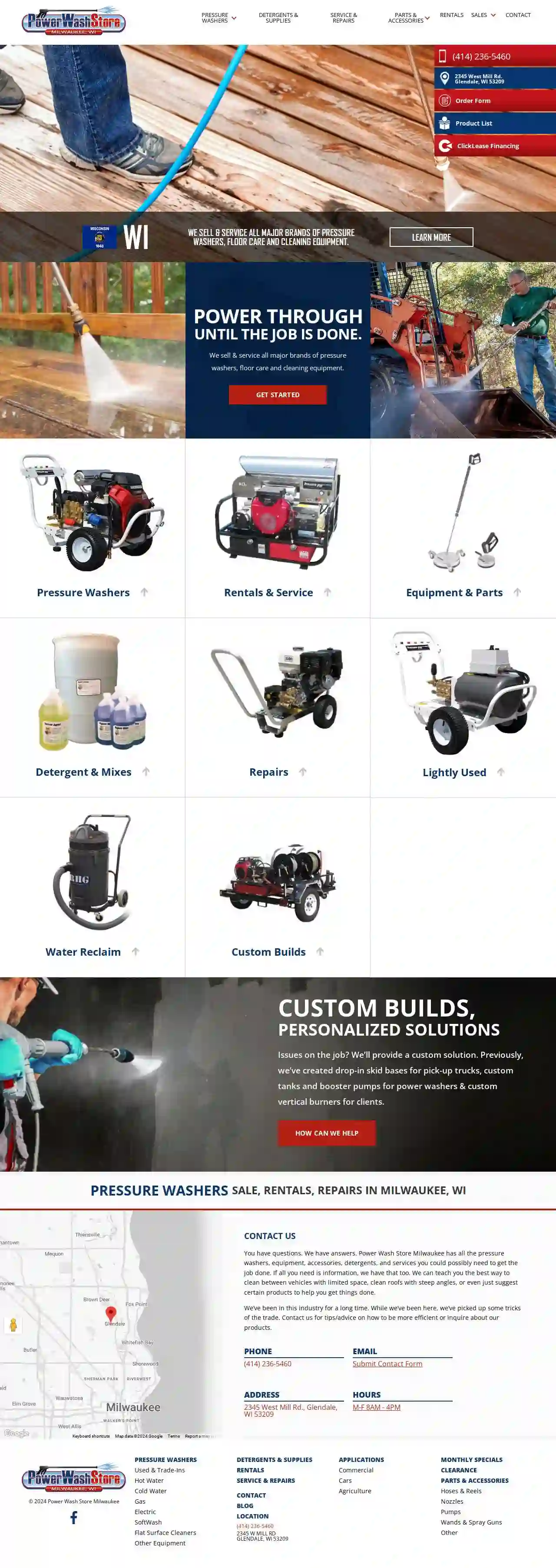Pressure Washing Whitefish Bay
Find the best Deck and Fence Cleaning in Whitefish Bay
Receive 3 FREE Pressure Washing quotes for your project today! Compare profiles, reviews, accreditations, portfolio, etc... and choose the best deal.

Pressure Wash 360 - Pressure Washing Co.
52 reviewsEAU CLAIRE, Eau Claire, 54701, USPressure Wash 360 is the #1 source for professional pressure washing, power washing, deck cleaning, building pressure washing, TPO and PVC rubber roof cleaning, and lake home washing in the Chippewa Valley! We have over 20 years of pressure washing restoration solutions. Pressure Wash 360 is not just another pressure washing and pressure cleaning company. We pride ourselves on being the industry leader in fire damage restoration, TPO and PVC rubber roof cleaning, building washing, house washing, lake and log home siding cleaning, deck cleaning, gutter cleaning, ice damming, concrete cleaning, and historical stone restoration. We will provide to our clients first-class pressure washing solutions with an emphasis on servicing it right the first time. We provide the very best customer service experience of anyone in the service industry. Need Pressure Washing Services?
- Services
- Why Us?
- Gallery
Get Quote
A & B Pressure Washing
52 reviews11731 Deer Ridge Rd, Wisconsin Rapids, 54494, USA & B House & Power Washing is a locally owned and operated pressure washing service provider serving the greater Wisconsin Rapids and Central Wisconsin area. We offer complete house and power washing services for residential, commercial, and municipal facilities. We pride ourselves on treating every home like our own, ensuring quality service and exceeding expectations. Our team is dedicated to providing free estimates and explaining our cleaning process thoroughly.
- Services
- Why Us?
- Gallery
Get Quote
Sparkle Wash Eau Claire
4.849 reviewsMilwaukee, USSparkle Wash is a professional pressure washing company that provides reliable and efficient cleaning services for residential, commercial, and industrial properties. With years of experience and a team of skilled professionals, we use the latest equipment and cleaning agents to get the job done right. Our services include building exterior washing, condominium and apartment complex cleaning, commercial concrete cleaning, graffiti removal, ice dam removal, industrial pressure washing, post construction clean up, and more. We also offer specialized services for fleet, agricultural, and marine properties. Contact us today to schedule your appointment and get a free quote!
- Services
- Why Us?
- Gallery
Get Quote
Pressure Pro Exteriors
578 reviewsWest Bend, WI, 4916 Cal Dr., 53095, USCelebrating our 7th year of providing the best exterior cleaning services in West Bend, WI. We offer Window Cleaning, Pressure Washing, gutter Cleaning, Ice dam removal & More! We understand the stress of hiring a cleaning company. Let us show you how easy it is! We are here to answer questions and educate every step of the way. Our customers are our family and 5 star service is what we provide to every one of our customers from start to finish. If you are not happy neither are we. We can’t wait to work with you on your next project!
- Services
- Why Us?
- Our Team
- Testimonials
- Gallery
Get Quote
Sparkle Wash Central State Washing
53 reviewsMilwaukee, USSparkle Wash Central State Pressure Washing provides a variety of power washing and restoration services in the commercial, residential and fleet markets. Our technicians are trained to pressure wash houses to multi-floor office buildings and everything in-between. No project is too big — or too small. As pressure washing experts, we pride ourselves on training, experience and reliability. We recognize that every project is different, and we can quickly assess what’s needed from different water pressures to effective cleaning agents. At Sparkle Wash, we cater our services to your needs and recommend a customized plan that’s right for you and your budget.
- Services
- Why Us?
- Gallery
Get Quote
Midwest Power Washing, LLC
4.949 reviewsNot provided on the website, USMidwest Power Washing is a professional pressure washing company based in Eau Claire, WI. They offer a variety of services including house washing, roof cleaning, gutter cleaning, commercial pressure washing, agricultural equipment cleaning, heavy equipment cleaning, fleet washing, ice dam removal, and Christmas light installation. Their team is committed to providing 100% satisfaction with their services, focusing on safety, cost-effectiveness, customization, and eco-friendliness.
- Services
- Why Us?
- Accreditations
- Our Team
- Testimonials
- Gallery
Get Quote
Mobi Clean pressure washing
55 reviews2401 West Mill Rd, Glendale, 53209, USMidwest Fleet Wash is a premier fleet washing and equipment cleaning provider in the greater Milwaukee area. As a division of the well-established Midwest Maintenance LLC, we offer a wide range of cleaning services to keep your fleet looking its best. Our fleet washing services include truck, trailer, and other equipment cleaning. We are committed to giving our customers the highest level of service, with no fluff. We understand that taking the time to use the proper tools and techniques while pressure washing any piece of equipment is crucial.
- Services
- Why Us?
- Accreditations
- Gallery
Get Quote
Sparkle Wash Fox Valley
4.7331 reviews49272, USIf You’re Looking For A High Quality, Reliable, Cost-Effective Pressure Washing Company. You’ve Found It. Sparkle Wash Fox Valley Professional Pressure Washing provides a variety of power washing and restoration services in the commercial, residential and fleet markets. Our technicians are trained to pressure wash houses to multi-floor office buildings and everything in-between. No project is too big — or too small. As pressure washing experts, we pride ourselves on training, experience and reliability. We recognize that every project is different, and we can quickly assess what’s needed from different water pressures to effective cleaning agents. At Sparkle Wash, we cater our services to your needs and recommend a customized plan that’s right for you and your budget. Make Sparkle Wash Your
- Services
- Why Us?
- Gallery
Get Quote
Tri-State Pressure Washing
5907 State Highway 33, Cashton, 54619, USTri-State Pressure Washing, LLC is a locally owned and operated company serving the Cashton, WI area. We specialize in providing affordable and eco-friendly pressure washing solutions for both residential and commercial properties. Our team is dedicated to customer satisfaction, offering years of experience and a commitment to detail. We prioritize your property, your community, and the environment, ensuring a thorough and safe cleaning process. Whether it's decks, patios, driveways, buildings, or even cars, we have the expertise and equipment to handle a variety of surfaces. We take pride in building lasting relationships with our customers, providing honest and reasonable prices for exceptional service.
- Services
- Why Us?
- Gallery
Get Quote
Power Wash Store Milwaukee
4.843 reviews2345 West Mill Rd., Glendale, WI 53209, Milwaukee, 53209, USPower Wash Store Milwaukee is a leading provider of pressure washers, floor care, and cleaning equipment. They offer a wide range of products and services including rentals, repairs, and custom builds. Their team is dedicated to providing the best solutions for their customers' cleaning needs.
- Services
- Why Us?
- Accreditations
- Our Team
- Testimonials
- Gallery
Get Quote
Over 60,241+ Janitorial Companies in our network
Our janitorial pros operate in Whitefish Bay & surroundings!
CleaningMatch has curated and vetted the Best Janitorial Services arround Whitefish Bay. Find a top & reliable business today.
Frequently Asked Questions About Pressure Washing
- Soft Washing: Soft washing is generally recommended for wood decks as it uses lower pressure and specialized cleaning solutions to safely remove dirt, mildew, and algae without causing damage.
- Lower Pressure Setting: If using a pressure washer on a wood deck, use a lower pressure setting (around 1500 PSI) and a wide-angle nozzle (25-40 degrees).
- Maintain Distance: Hold the nozzle at least 12 inches away from the deck surface to prevent etching or splintering.
- Professional Pressure Washing: If you're unsure about pressure washing your deck safely, hire a professional pressure washing company with experience in cleaning wood surfaces.
- Size of the Area: Larger areas generally cost more to pressure wash than smaller ones.
- Type of Surface: Different surfaces require different pressure levels and cleaning solutions, which can affect pricing.
- Condition of the Surface: Heavily soiled or stained surfaces may require more time and effort to clean, impacting cost.
- Accessibility: Difficult-to-reach areas may require specialized equipment and increase costs.
- Additional Services: Services like pre-treating stains, applying protective coatings, or mold removal may incur additional charges.
- Driveways: Removes oil stains, tire marks, dirt, and grime, restoring the appearance of concrete, asphalt, or paver driveways.
- Decks and Patios: Cleans wood, composite, or concrete decks and patios, removing dirt, mildew, and algae, and preparing them for staining or sealing.
- Fences: Revitalizes wood, vinyl, or composite fences, removing dirt, grime, and weathering, and enhancing their appearance.
- Siding: Cleans vinyl, aluminum, brick, or wood siding, removing dirt, mold, mildew, and other contaminants, and restoring its original color.
- Roofs: Removes moss, algae, and other debris from roofs, extending their lifespan and improving their appearance. Soft washing is typically recommended for roof cleaning to prevent damage.
- Walkways and Sidewalks: Cleans concrete or brick walkways and sidewalks, removing dirt, grime, and stains, and improving safety by reducing slipperiness.
- Brick and Stone: Cleans brick and stone surfaces, removing dirt, mildew, and efflorescence, and restoring their natural beauty.
- Using Excessive Pressure: High-pressure water spray can damage delicate surfaces like wood siding or painted surfaces.
- Using the Wrong Nozzle: Different nozzles produce different spray patterns and pressure levels. Using the wrong nozzle can cause streaks, uneven cleaning, or damage.
- Holding the Nozzle Too Close to the Surface: Holding the nozzle too close can etch or damage the surface. Maintain a safe distance as recommended by the pressure washer manufacturer.
- Skipping Pre-Treatment: For stubborn stains or mold growth, pre-treating the surface with a cleaning solution can enhance cleaning effectiveness.
- Not Protecting Plants and Landscaping: Pressure washing chemicals and debris can harm plants and landscaping. Cover or shield sensitive areas before pressure washing.
Can pressure washing damage my deck?
By using the right cleaning method and precautions, you can effectively clean your wood deck without causing damage and prolong its lifespan.
How much does pressure washing cost?
To get accurate pricing, request quotes from multiple pressure washing companies. Provide details about the size and type of surface, its condition, and any additional services you require.
What surfaces can be pressure washed?
It's important to note that different surfaces require different pressure levels and cleaning solutions. Always consult with a professional pressure washing company to determine the appropriate cleaning method for your specific needs.
What are some common pressure washing mistakes to avoid?
If you're unsure about pressure washing techniques or the appropriate pressure levels for your surfaces, consult with a professional pressure washing company.
Can pressure washing damage my deck?
- Soft Washing: Soft washing is generally recommended for wood decks as it uses lower pressure and specialized cleaning solutions to safely remove dirt, mildew, and algae without causing damage.
- Lower Pressure Setting: If using a pressure washer on a wood deck, use a lower pressure setting (around 1500 PSI) and a wide-angle nozzle (25-40 degrees).
- Maintain Distance: Hold the nozzle at least 12 inches away from the deck surface to prevent etching or splintering.
- Professional Pressure Washing: If you're unsure about pressure washing your deck safely, hire a professional pressure washing company with experience in cleaning wood surfaces.
By using the right cleaning method and precautions, you can effectively clean your wood deck without causing damage and prolong its lifespan.
How much does pressure washing cost?
- Size of the Area: Larger areas generally cost more to pressure wash than smaller ones.
- Type of Surface: Different surfaces require different pressure levels and cleaning solutions, which can affect pricing.
- Condition of the Surface: Heavily soiled or stained surfaces may require more time and effort to clean, impacting cost.
- Accessibility: Difficult-to-reach areas may require specialized equipment and increase costs.
- Additional Services: Services like pre-treating stains, applying protective coatings, or mold removal may incur additional charges.
To get accurate pricing, request quotes from multiple pressure washing companies. Provide details about the size and type of surface, its condition, and any additional services you require.
What surfaces can be pressure washed?
- Driveways: Removes oil stains, tire marks, dirt, and grime, restoring the appearance of concrete, asphalt, or paver driveways.
- Decks and Patios: Cleans wood, composite, or concrete decks and patios, removing dirt, mildew, and algae, and preparing them for staining or sealing.
- Fences: Revitalizes wood, vinyl, or composite fences, removing dirt, grime, and weathering, and enhancing their appearance.
- Siding: Cleans vinyl, aluminum, brick, or wood siding, removing dirt, mold, mildew, and other contaminants, and restoring its original color.
- Roofs: Removes moss, algae, and other debris from roofs, extending their lifespan and improving their appearance. Soft washing is typically recommended for roof cleaning to prevent damage.
- Walkways and Sidewalks: Cleans concrete or brick walkways and sidewalks, removing dirt, grime, and stains, and improving safety by reducing slipperiness.
- Brick and Stone: Cleans brick and stone surfaces, removing dirt, mildew, and efflorescence, and restoring their natural beauty.
It's important to note that different surfaces require different pressure levels and cleaning solutions. Always consult with a professional pressure washing company to determine the appropriate cleaning method for your specific needs.
What are some common pressure washing mistakes to avoid?
- Using Excessive Pressure: High-pressure water spray can damage delicate surfaces like wood siding or painted surfaces.
- Using the Wrong Nozzle: Different nozzles produce different spray patterns and pressure levels. Using the wrong nozzle can cause streaks, uneven cleaning, or damage.
- Holding the Nozzle Too Close to the Surface: Holding the nozzle too close can etch or damage the surface. Maintain a safe distance as recommended by the pressure washer manufacturer.
- Skipping Pre-Treatment: For stubborn stains or mold growth, pre-treating the surface with a cleaning solution can enhance cleaning effectiveness.
- Not Protecting Plants and Landscaping: Pressure washing chemicals and debris can harm plants and landscaping. Cover or shield sensitive areas before pressure washing.
If you're unsure about pressure washing techniques or the appropriate pressure levels for your surfaces, consult with a professional pressure washing company.